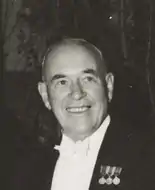| |||||||||||||||||||||||||||||||||||||||||||||
44 (of the 65) seats in the Victorian Legislative Assembly | |||||||||||||||||||||||||||||||||||||||||||||
|---|---|---|---|---|---|---|---|---|---|---|---|---|---|---|---|---|---|---|---|---|---|---|---|---|---|---|---|---|---|---|---|---|---|---|---|---|---|---|---|---|---|---|---|---|---|
| |||||||||||||||||||||||||||||||||||||||||||||
| |||||||||||||||||||||||||||||||||||||||||||||
The 1940 Victorian state election was held in the Australian state of Victoria on Saturday 16 March 1940 to elect 44 of the 65 members of the state's Legislative Assembly.
Background
Several events had taken place since the previous state election on 2 October 1937, which had changed the breakdown of the parties in the Assembly:
- In November 1937, Ian Macfarlan (the member for Brighton) left the United Australia Party (UAP) and sat as an Independent. Macfarlan gave two reasons for his resignation from the UAP: that the party was sitting in opposition to the Dunstan Country government which he praised; and that it was controlled by a central body outside of the parliament, the members of which were unknown to most party members.[1] Frederick Holden (Grant) also left the UAP and sat on the cross benches.[2] This reduced the UAP's numbers from 21 to 19.
- Ernie Bond (Port Fairy and Glenelg) had been expelled from the Labor Party (ALP) over his support for the "Premiers' Plan" in 1932, and had won several elections as an independent. He was re-admitted to the ALP in on 16 April 1938.[3] This increased the ALP's numbers from 20 to 21.
- On 5 November 1938, the United Country Party (UCP) won a by-election in the seat of Gippsland North, after the death of the sitting member James Weir McLachlan, an independent.[4] This reduced the number of Independents to 3, and increased the numbers for the UCP from 20 to 21.
- In August 1939, Alfred Kirton (Mornington) resigned from the UAP and sat briefly as an independent, before joining the United Country Party on 29 August 1939. This reduced the UAP from 19 seats to 18, and increased the UCP seats from 21 to 22.[5]
- In 1939 Frederick Cook (Benalla) moved from being an Independent to joining the Liberal Country Party, a breakaway group from the Country Party who supported the federal party's participation in a Coalition government.[6]
Results
Legislative Assembly
|
Victorian state election, 16 March 1940[7][8] | ||||||
|---|---|---|---|---|---|---|
| Enrolled voters | 841,864 | |||||
| Votes cast | 786,359 | Turnout | 93.41 | −0.55 | ||
| Informal votes | 12,287 | Informal | 1.56 | +0.19 | ||
| Summary of votes by party | ||||||
| Party | Primary votes | % | Swing | Seats | Change | |
| United Australia | 274,113 | 35.41 | −4.15 | 16 | −2 | |
| Labor | 256,744 | 33.17 | −7.86 | 22 | +1 | |
| United Country | 109,626 | 14.06 | −2.71 | 22 | ±0 | |
| Liberal Country | 18,104 | 2.34 | +2.34 | 1 | ±0 | |
| Communist | 2,935 | 0.38 | −0.34 | 0 | ±0 | |
| Independent | 112,550 | 14.53 | +7.20 | 4 | +1 | |
| Total | 774,072 | 65 | ||||
See also
References
- ↑ "DUNSTAN GOVERNMENT PRAISED". Gippsland Times. Vic.: National Library of Australia. 25 November 1937. p. 6. Retrieved 22 May 2012.
- ↑ "SIGNIFICANCE OF SEATS". The Argus. Melbourne: National Library of Australia. 20 October 1937. p. 3. Retrieved 22 May 2012.
- ↑ "READMITTED TO LABOR PARTY". The Advocate. Burnie, Tas.: National Library of Australia. 19 April 1938. p. 11. Retrieved 22 May 2012.
- ↑ "BY-ELECTION IN VICTORIA". The Mercury. Hobart, Tas.: National Library of Australia. 9 November 1938. p. 11. Retrieved 22 May 2012.
- ↑ "U.C.P. RECRUIT". The Argus. Melbourne: National Library of Australia. 30 August 1939. p. 10. Retrieved 22 May 2012.
- ↑ Parliament of Victoria (2001). "Cook, Frederick Albert". re-member: a database of all Victorian MPs since 1851. Parliament of Victoria. Retrieved 8 December 2015.
- ↑ Election held on 16 March 1940, Australian Politics and Elections Database (University of Western Australia).
- ↑ Colin A Hughes, A Handbook of Australian Government and Politics 1890-1964, Canberra: Australian National University Press, 1968 (ISBN 0708102700).
This article is issued from Wikipedia. The text is licensed under Creative Commons - Attribution - Sharealike. Additional terms may apply for the media files.

.jpg.webp)
.png.webp)